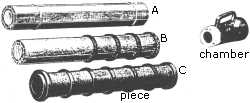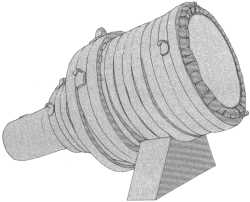The Gun - The First Guns | |
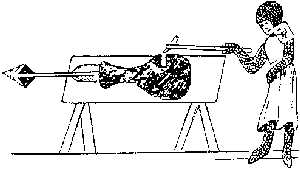
|
The genius who realised that gunpowder could be used as a propellant remains unknown. All we do know is that the first illustration of a piece of ordnance occurs in a treatise by one Walter de Millemete entitled De Officiis Regum (On the Duties of Kings). Dated 1326, it is preserved in the library of Christ Church, Oxford. The gun was called a vaso from the Italian for a vase which it closely resembled. The Gunner is pictured in the act of firing the piece by inserting a red-hot iron into the vent. The projectile leaving the muzzle was a species of arrow known as a dart, carreau or quarrel. The gun has no carriage; it simply lies on a trestle table. |
|
England lagged behind the rest of Europe in gun-making during the 14th century. Judging from the name vaso, Walter's gun was probably made in Italy which led Europe in metal-working at that time. Also, the earliest known reliable reference to guns occurs in a decree of 11 Feb 1326 by the Council of Florence ordering the casting of a quantity of brass pieces and iron shot. Guns were probably in use before 1326 but claims to that effect as yet lack supporting evidence. Unfortunately the text of Walter's work makes no reference to the illustration. As he was chaplain to King Edward I, possibly he inserted it out of deference to the King who is said to have been a keen artilleryman. Other Early GunsWe know that the earliest guns were cast from non-ferrous alloys, and the colour (gilt) of the piece in the original of the illustration above indicates it was made of a metal resembling brass, possibly bell metal. Extensive building of churches in Europe during the Middle Ages led to a steady demand for bells - and for bell-founders to switch to gun-founding would not have proved a difficult exercise.
| |
|
During the 14th and 15th centuries England bought most if not all her cast brass or bronze guns fdrom makers in Europe. When Henry VIII ascended the throne in 1509 the country had only one expert gun founder, a state of affairs he soon rectified by importing German, Italian and French gun founders not only to cast his ordnance but also to teach Englishmen how to do it. |
 14th Century vaso dug up in Sweden. |
Early Iron GunsGuns cast from non-ferrous alloys during the first half of the 14th century were small - and expensive - so gunmakers soon began to try iron. In Europe the technique of casting this metal was then very much in its infancy, so blacksmiths began forging guns from wrought iron. They were called bombards from the Greek bombos meaning a loud buzzing noise.To construct a bombard the smith first made a wooden cylinder called a mandrel of the same length as the desired piece, and of the same diameter as its bore. He then forged a number of iron bars of nearly rectangular section which he fitted closely together around the mandrel (A). Next he made a number of rings of internal diameter slightly less than the external diameter of the bars as assembled on the mandrel. He then heated the rings to white heat and fitted them over the bars so that on cooling they contracted, holding the bars very tightly together (B and C).
Before fitting the rings the smith in some cases poured molten lead into the gaps between the bars to prevent the escape of propellant gas. With heavier types the rings were usually placed end-to-end. The term gun barrel derives from this method of construction because the bars and rings correspond to the staves and bands respectively of the common wooden barrel. In small pieces instead of bars the smith sometimes bent a sheet of iron into a cylinder, welded the edges together and shrunk rings around it, as above. Bombards, especially those on which the rings were placed end-to-end, were thus pre-stressed in much the same way as built-up guns made five centuries later. Whether or not the makers realised this fact is not known. As the piece was built up on a mandrel it was open at both ends. Hence lighter types were made breech-loading, the makers fully realising the advantages of this system over muzzle-loading. The breech was in the form of a separate chamber, into which the powder charge was loaded, the open end being closed by a wooden plug. Then the shot was loaded into the barrel, the chamber inserted behind it, and kept in place by a wooden wedge. A fresh plug was required for each round.
| |
|
Smaller guns were usually supplied with one or more spare chambers which enabled a high rate of fire to be maintained for short periods. Heavier pieces of large calibre were muzzle-loading, a single chamber being screwed on to the barrel or otherwise attached to it. Mons Meg's chamber is screwed on to the piece.
|
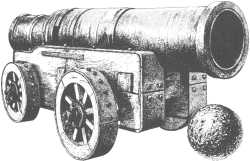 Mons Meg |
Obturation in Early Iron Guns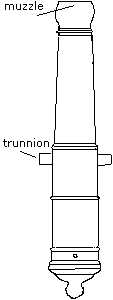 In the early breech-loading gun no matter how carefully the smith shaped the end of the chamber and the mouth of the breech into which it fitted, he found that efficient obturation, ie prevention of escape of propellant gas over or through the breech mechanism, was extremely difficult to achieve; some gas inevitably escaped, even in a new piece. As wear progressed more and more escaped, reducing efficiency as well as making life uncomfortable for the Gunner. The problem of obturation was not effectively solved until late in the 19th century. Until trunnions were invented in Flanders c.1450 no early guns were fitted with them. Despite their obvious advantages gunmakers long continued to omit them from wrought iron pieces because they complicated construction. By the end of the 15th century ML guns of cast non-ferrous alloys were fast superseding those of forged iron. A few BL pieces were made of these alloys but ML types predominated. No more forged iron guns were made after about 1520. Although not easy to load, ML guns had no obturation problems, while the bores of cast pieces were trued on a boring machine after manufacture which was not the case with forged pieces. Thus cast pieces tended to be more accurate. Furthermore, trunnions could be cast integral with the piece, ie did not have to be made separately and somehow attached to it.
| |
 |
Late 15th Century forged iron 'wall piece', ie designed for mounting on walls of castles or bulwarks of ships. Trunnions have been made separately, the trunnion ring being shrunk on to the barrel. The breech mechanism is an improvement on the earlier type, being entirely of iron and more positive in action. |
Cast Iron GunsAs far as we know guns of cast iron were first made in Italy towards the end of the 15th century, probably the oldest still in existence having been made by a member of the Albergetti family who operated in Ferrara during the period 1487-97. In England cast iron guns were first produced in 1508-09, not in 1543 as claimed by some historians who base their assertions on an uncorroborated statement by Holinshead, a 16th century chronicler who 'enjoyed a great reputation'. Cast iron evidence confirms 1508-09. Cast iron guns were favoured by the war lords because they were comparatively cheap, but not by the Gunners because they had a habit of bursting without warningn often with fatal results. On the other hand bronze guns usually forecast failure by first developing a bulge. Gunmakers Think BigUp to around 1400 the largest guns on record whether forged from iron or cast from 'brass' did not exceed five inches (12.7cm) in calibre.These pieces were useful in the anti-personnel role only; against fortified works they were comparatively ineffective. Now mediaeval warfare frequently involved sieges of castles or other fortified works. When confronted with such a work the attacker could choose: either surround it and starve the occupants into submission, or make a breech in a wall, send in a storming party, and settle the issue by combat. If time was short - and the garrison had provisions enough to prolong the outcome - the second choice was often preferable. The old mechanical 'engines of war', eg ballista and catapulta, the ancient equivalents of the gun and howitzer respectively, were ponderous and complicated contraptions, slow to set up and slower still to make an impression on heavy masonry. On the other hand the gun was comparatively simple to bring into action and man - if only its power could be increased. So early in the 15th century leading military men who were artillery-minded directed their gunmakers to build battering pieces capable of punching holes in stone walls. The same men who forged the smaller wrought iron bombards found making the heavier no more difficult. Indeed in some respects they found them easier for their size provided more 'hammer room'. To achieve the desired destructive effect with the low muzzle velocities mediaeval powder produced, the stone roundshot the Gunners were obliged to use had to be heavy and consequently of large calibre. Some of the great bombards constructed were large even by modern standards. Calibres up to 36 inches (91cm) are recorded. Mortars and HowitzersMediaeval Gunners were also aware of the damage a heavy stone shot could do to buildings etc within a fortress when lobbed over the wall at high angle. In addition the first incendiary shells were produced in 1460. Both mortars and howitzers of large bore and short barrel were therefore made at the same time as the heavy bombards designed for battering purposes.
| |

15th century mortar on mobile carriage. |
|
|
Like the heavier bombards, mortars and howitzers were muzzle-loading. Standardisation of OrdnanceIn the very beginning before artillery became organised the manufacture of guns was a pretty haphazard business. Each maker would produce a gun designed according to his personal whim or fancy. No attempt was made to standardise during the 14th century. When the King went to war he hired both the gun and its maker who manned it in action. Thus the first Master Gunners were master smiths or master founders; they were not soldiers but civilian tradesmen.
| |
|
Master Gunners christened individual pieces with names (mostly female) which reflected their efficiency or otherwise, such as Lioness or Lazy Girl, or after the place of manufacture, eg Mons. The Meg part of Mons Meg was added in the 16th century. The scots called her Mounts or Mounce and were very proud of her because she was bigger than any gun the English had. A saying common in Scotland in her time was '...the devill shoote Mounts up your arse', the meaning of which is clear. We shall see more of her in the chapter on carriages to follow. |
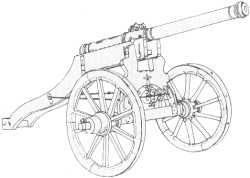 Bronze falconet
|
By the early 1400s there had evolved types of pieces most of which were named after fabulous beasts or birds of prey, chief of which in descending order of size and calibre were: basilisk (8.75 inches), cannon (6 - 8.5), culverin (4.5 - 5.5), saker (around 3.5), minion (3.25), falcon (2.5) and falconets (around 2 inches). But there were variations within these types in both size and calibre. For example there were three sakers, a larger (8-pr), an ordinary (6-pr) and a smaller (5-pr). Where a gun seemed to belong to a certain type but was a bit odd it was called a bastard. And there were bastards in most types! Besides those types quoted above there existed a host of others, eg slings, murtherers, flankers, shrimps, orgues, aspics, sparrows, etc details of which have long been lost.
|
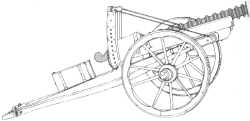 3in Culverin c. 1460
|
|
That the situation in battle was chaotic must be the understatement of all time. Not only were there large numbers of guns in either army of greatly differing calibres, such technicalities as tolerances in dimension were quite unknown. Thus the supply of ammunition must have created the father of all headaches! Not until the 17th century did things really improve with the designation of ordnance being placed on a sounder footing. We shall look at this aspect in a later chapter. WL Ruffell previous | index | next | History index | Home | |
